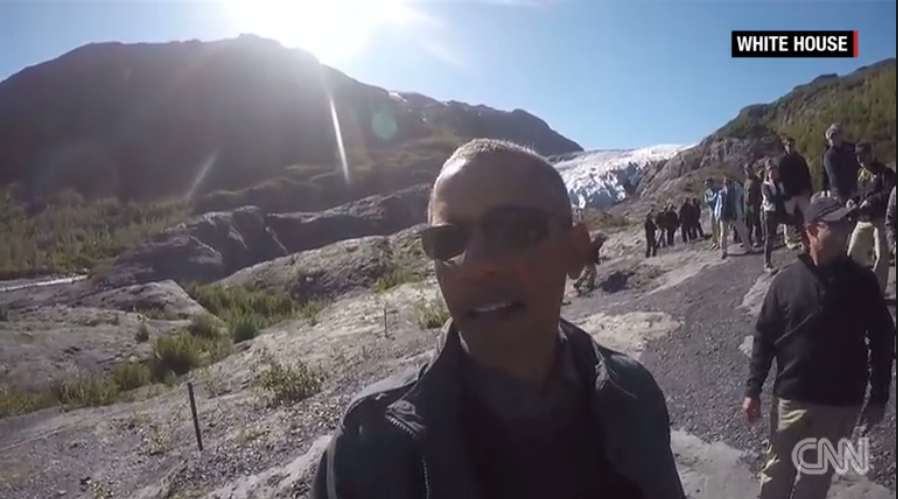This Week: Polar Bears and #ObamaSelfies: The Critical Intersections of Digital Humanities and Environmental Justice
Each week, a member of the JITP Editorial Collective assembles and shares the news items, ongoing discussions, and upcoming events of interest to us (and hopefully you). This week’s installment is edited by Amanda Starling Gould.
This week’s roundup looks at the intersections of digital humanities (DH) and environmental justice.
Polar bears are trending this week on my Twitter and Facebook feeds. Four in particular:
HORRIFYING: The future of #polarbear, in one photograph> http://t.co/mTAqD4bXIL @dodo pic.twitter.com/HxD4tLG2Gd
— Earthjustice (@Earthjustice) September 6, 2015
Performance art activism! Greenpeace parks a giant polar bear outside Shell's London HQ: http://t.co/D8PXNLgee4 pic.twitter.com/UzkTcJiBKV”
— Amanda S Gould (@stargould) September 2, 2015
https://instagram.com/p/4kDKJvxJAM/
These polar bears have come to represent this week’s debates on climate change—especially those critiquing the ethical and political stakes of President Obama’s recent trip to Alaska to speak at the GLACIER Conference in Anchorage.
Debates aside, part of that trip included a heavy dose of Obama selfies.
President Obama even does a ‘selfie video’ with a glacier:
Though it is fun and perhaps noteworthy that our president is using social media, what is more exciting is the potential for this form of #Selfie + #ClimateChange (or #ActOnClimate as @WhiteHouse uses above) to be a digital call for environmental action.
This provokes several questions that are currently bubbling at the core of much of my own recent work and teaching: How can we use digital tools and methods to productively address environmental issues? How could we design classroom and research assignments that use digital media and DH methods to productively interrogate complex environmental issues? As we use DH tools to discuss environmental issues, how can we use the very materialities of the digital infrastructure—from its complex mineral composition to our resource-hungry data centers and toxic e-waste accumulations—to critically address both DH and environmental justice?
President Obama’s selfies are certainly one place to start. What if Californians began taking selfies with their drought-parched patches? What if Oregonians began taking selfies with their raging wildfire megablazes? What if we extended this #SelfieWithClimateChange challenge to commuters in Beijing or failing farmers in New Zealand? If we had our students use Instagram and Twitter to solicit such images, and then asked our students to work collaboratively to curate those images into a digital project, would this inspire reflection on climate change issues? I’m guessing so. And I’m guessing this is a small part of what President Obama was performing during his trip.
This week as California conserves water and the west coast fights wildfires caused by severe dryness, California governor Jerry Brown tells the state, in a trending online video, that “[t]his is the future, from now on. It’s going to get worse, just by the nature of how the climate’s changing.”
California's 2015 Sierra Nevada mountains snowpack was "the worst in the past 500 years" http://t.co/gSnq6184Fk pic.twitter.com/SplXoJ25jl
— NYT Science (@NYTScience) September 15, 2015
On Monday, @NYTScience tweeted a new NYTimes.com article on California’s ‘historic’ drought that quotes bioclimatoligist A Park Williams who two weeks ago released a report stating that “[a]nthropogenic warming has intensified the recent drought as part of a chronic trend toward enhanced drought that is becoming increasingly detectable and is projected to continue growing throughout the rest of this century.”
If this digital media environmentalism is making a persuasive impact on popular sentiment or is resulting in a heightened awareness of earth stewardship is not entirely known. What does seem to be increasingly evident, however, is the indication that digital interactive tools, from social media to more sophisticated DH projects, have as important a role to play in environmental justice as they do in social justice which seems to be the more prevalent current DH cause.
Knowing that the production, manufacture, waste, and energetic requirement of our digital media devices are actively contributing to the earth’s progressively detrimental state, those of us teaching with technologies, especially those of us teaching socially-minded DH-specific or DH-inflected courses, should take a moment to consider how we might ground those technologies in their own particular environmental contexts, and how we might use those technologies to interrogate—and effectively communicate—today’s important environmental issues.
-Amanda Starling Gould
@stargould
Featured image of President Obama courtesy of CNN.com.




